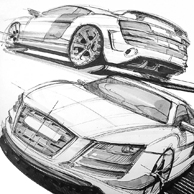Car design
Automotive design
Car design is a design discipline dedicated to designing the appearance and ergonomics of automobiles. More generally, the term Automotive design is used in the case of motorcycles, trucks, buses, coaches and vans.
The design of a car includes different skills and is generally carried out by a team of professionals with different skills.
Car design is primarily concerned with developing the visual appearance or aesthetics of the vehicle, as well as participating in the creation of the product concept. Automotive design is practiced by designers who may have an artistic background and a degree in industrial design or transportation design.
The task of the design team is usually divided into three main aspects: exterior design, interior design and color and finish design.
Graphic design is also an aspect of automotive design that is generally shared among the design team.
The car design not only focuses on the isolated external shape of the automotive parts, but focuses on the combination of form and function, starting with the vehicle package.
The aesthetic value also includes and corresponds to the ergonomic functionality and utility features. In particular, vehicle components and electronic parts will offer greater challenges to automotive designers who are required to keep abreast of the latest information and knowledge associated with emerging vehicular gadgets, especially mobile dashboard devices, such as GPS navigation, satellite radio, HD radio, mobile TV, MP3 players, video playback and smartphone interfaces. While not all new in-vehicle gadgets need to be designated as factory standard items, some of them may be integral to determining the future course of any specific in-vehicle model.
Exterior design
The design team responsible for the exterior of the vehicle develops the proportions, shape and surface details of the vehicle. The exterior design is first performed by a series of manual sketches and digital drawings. Progressively, more detailed drawings are executed and approved by appropriate management levels, followed by digital rendering of the images. Consumer feedback is generally requested at this point to help iteratively refine vehicle concepts based on the target market and will continue throughout the rest of the design refinement process. After a more progressive refinement, industrial plasticine and / or digital models are developed from and together with the drawings and images. The data from these models is then used to create quarter-scale and finally full-size models of the final design. With three- and five-axis CNC milling machines, the clay model is first designed in a computer program and then "sculpted" using the machine and large amounts of clay. Even in times of high-class 3D (three-dimensional) software and virtual models on electric walls, the clay model is still the most important tool for a final assessment of a vehicle's exterior design and, therefore, is used across the industry.
Interior design
The vehicle interior designer develops the proportions, shape, placement and surfaces for the dashboard, seats, door trim panels, roof trim, pillar trim, etc. Here the emphasis is on ergonomics and passenger comfort. The procedure here is the same as for the exterior design (sketch, digital model and clay model).
Color and finish design
The color and trim (or color and materials) designer is responsible for researching, designing and developing all interior and exterior colors and materials used on a vehicle. These include paint, plastic, fabric design, leather, grain, carpet, headlining, wood trim and so on. Color, contrast, texture and pattern must be carefully combined to give the vehicle a unique interior environment experience. Designers work closely with exterior and interior designers.
Designers draw inspiration from other design disciplines such as: industrial design, fashion, home furnishings, architecture and sometimes product design. Specific research on global trends is conducted to design projects for two or three model years in the future. Trend cards are created from this research to track design influences in relation to the automotive industry. The designer then uses this information to develop themes and concepts which are then further refined and tested on vehicle models.
Graphic design
The design team also develops graphics for elements such as badges, decals, dials, switches, tread or tread, liveries.
Computer Aided Design and Class A Development
Sketches and rendering are transformed into 3D digital surface modeling and rendering for real-time evaluation with early-stage mathematical data. During the development process, the next steps will require the fully developed 3D model to meet a designer's aesthetic requirements and all engineering and manufacturing requirements. The fully developed CAS digital model will be reworked for production that meets Class A surface standards involving both technical and aesthetic aspects. This data will be further developed by a team of product engineers. These modelers usually have training in industrial design or sometimes tool engineering in the case of some Class A modelers. Autodesk Alias ‚Äč‚Äčand ICEM Surf are the two most used software tools for Class A development.































